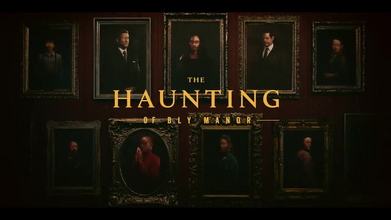The Haunting of Bly Manor is the latest installment in The Haunting anthology created by Mike Flanagan for Netflix. The series consists of nine episodes, and follows the story of an au pair who arrives at the haunted estate of Bly Manor.
The series uses horror elements in a very understated way; it elects to hide ghosts in the background that often go unseen rather than to have jumpscare after jumpscare. It has an overall eerie tone – a large, old house and two children who advise their governess not to roam the grounds after dark – but it is very slow burn, which becomes one of its faults. The series takes several episodes before a cohesive storyline begins to unfold, but once the inklings of an intriguing plot emerge, it becomes too complicated. Bly Manor has a massive cast: the au pair, the two children, their uncle, the housekeeper, the gardener, the cook, the dead parents, the previous governess, and many other characters introduced through flashbacks. What Bly Manor does well is showcase the talent of the many actors, however it fails to set up a clear, main storyline supported by the side characters. Instead, it gives each character a subplot and while all of the characters are genuinely well-written and interesting, the show does not give itself enough time to fully flesh out each subplot and tie them each into the main storyline.
The second-to-last episode, “The Romance of Certain Old Clothes,” is the weakest episode even though it is supposed to serve as the explanation as to why the estate of Bly Manor is haunted, what happened to the current governess’s predecessor, and why any of this is relevant to the current staff of Bly Manor. It comes across as a filler or even throw-away episode, and it adds another layer of confusion to the story. I understand that Flanagan wants to retain an air of mystery to keep the audience engaged, however when the story is so confusing for so many episodes, it becomes frustrating to watch. Ultimately, the series wastes a decent amount of time keeping the audience in the dark, resulting in a rushed conclusion of the ghost story before moving on to conclude the ongoing story of love and loss. That being said, one thing that Flanagan does well is create a bittersweet ending that emulates the central theme that to truly love someone is to accept that loving them is worth the risk and pain of losing them. However, though the last 15 minutes of the final episode carry the entire show, it cannot be ignored that the majority of the show is too slow, and that Flanagan adds another subplot in the second-to-last episode that only opens up more plot holes.
Finally, I cannot review Bly Manor without discussing its predecessor, The Haunting of Hill House. Hill House is overall a tighter and cleaner story that does a better job of balancing horror and very human themes – grief and guilt, in this case. Flanagan ties in fear as a projection of guilt and trauma in this series – rather than a separate and debatably related aspect – with a satisfying conclusion addressing family and forgiveness. However, Hill House also falls into a lull with the two episodes before the finale, but those episodes act more as a set-up for the finale rather than an entirely new addition to the story like in Bly Manor.
Overall, I expected both series to come to a huge, dramatic, maybe even disturbing conclusion, but what Flanagan choses to do instead is to subvert expectations and craft two conclusions that that are empathetic and wistful. The last fifteen minutes of Bly Manor and the finale of Hill House showcase Flanagan’s ability to depict compelling stories of human relationships, which is ultimately what draws a large fanbase to the two shows.


